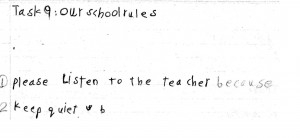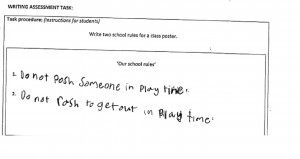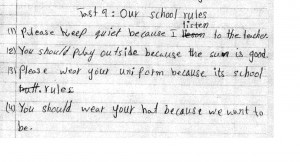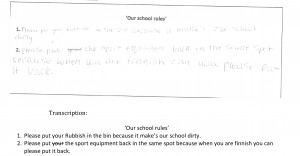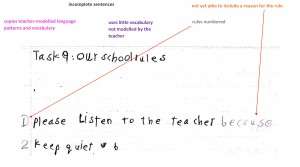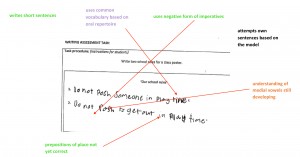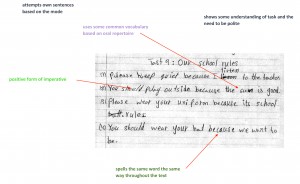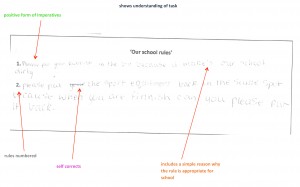Please click on the toggles below to navigate through information on this assessment task and reveal the links for downloading task materials.
Task details |
|
| Name of writing assessment task | Our school rules |
| EAL curriculum level range | A2, BL, B1, B2, CL, C1, C2 |
| Text orientation | Persuasive |
| Task type | Cued response |
Task specification |
|
| Purpose | To assess students’ ability to write school rules and to provide reasons for the rules. |
| Description | Students write rules for a class reminder poster. |
| Assumed knowledge and description |
|
Learning/teaching context |
|
| Language centre/mainstream class | Small group |
| Subject/key curriculum objectives, outcomes | English |
| Topic/teaching unit | School |
| Assessment conditions |
|
| Notes |
|
Task implementation |
|
| STAGE | ACTION STEPS |
| Pre-assessment activity |
- Please walk in the classroom. Don't run! - Please put rubbish in the rubbish bin. - Please listen carefully. - Please be friendly to each other. - Please pack up the toys and games at the end of the lesson.
Please walk in the classroom, don't run. Why? -Because you could fall over. - Because you could push someone over. Please put your rubbish in the rubbish bin. Why? - Because we want a clean classroom. - Because rubbish is messy. |
| Assessment activity |
|
| Post-assessment activity |
|
- TEAL Writing Task 9 – unmarked criteria sheet [PDF]
- TEAL Writing Task 9 – unmarked criteria sheet [Word]
An explanation of the purpose, nature and use of criteria sheets is available at 4. Using the assessment criteria.
Purpose and nature of the task
This task involves students in writing a text about a topic that they are likely to have some familiarity with, even at very early stages of oral English language development. It has descriptive and persuasive elements because the students are asked to describe school or class rules and the reasons for them. In this task students are asked provide a cued response. This task is suited more to EAL learners at the earlier stages of their EAL learning. It is related to TEAL Oral Task 9: Our school rules.
Commentary
Two of these samples were produced in the context of a secondary new arrivals EAL/literacy class and two were produced in small group EAL classes in mainstream primary schools. The students had access to modelled rules and reasons. The students were given the task sheet, which guided their writing of the rules.
All the students produce comprehensible writing, but the student who wrote Sample 1 is limited to copying the teacher’s model text. Samples 1 and 2 do not give reasons for the rules whereas Samples 3 and 4 are more successful in addressing the requested inclusion of reasons for the rules. Although the students who wrote Samples 2 and 4 have attempted to express some variation with developing control over grammatical structures, overall the students have produced sentences with little variation of form, suggesting that they have closely followed the model. Because of their stage of English language development (and experience with writing in English) the students may not yet be able to use their own words and constructions to express their ideas.
Sample 1
Age/year level: lower secondary
Language: Dari
This sample shows that the student has made extensive use of teacher support by carefully copying modelled sentence beginnings provided but has not been able to complete the sentences or provide reasons for the rules. The student has self-corrected an error and is still to complete copying the second sentence beginning.
The text shows that the student needs may need to learn more vocabulary around the topic, and further modelling to complete the sentences by adding reasons.
The sample shows an awareness that English is written from left to right and that spaces are needed between words. The words are written legibly in the student’s own handwriting style.
The student is able to form most letters correctly but is not yet clearly using upper and lower case letters, nor any punctuation.
The marked criteria sheet shows that the student meets most criteria at level 1 of performance.
The student’s language use in this task is consistent with the descriptions of students at Level CL, Victorian Curriculum F-10 EAL.
TEAL Writing Task 9 – criteria sheet – Sample 1
Using this assessment for further learning
(Select the points you think are currently of most importance to the student.)
Student working at this level greatly benefit from taking part in a wide range of modelled writing tasks for a range of clear purposes. Joint construction of texts supports students as they attempt their own writing. Oral activities, such as picture discussions, role plays and drama, prior to writing, are important to build up topic vocabulary and structures, as are class and individual collections of common and topic-specific vocabulary. Groupings of known words into phonetic categories such as those with the same starting letters, and other spelling patterns will assist students to understand sound–letter relationships and patterns in English
Photos of the student engaging in role plays, with speech balloons and thought bubbles, could model the repercussions of following and not following the school rules.
The student would also benefit from vocabulary extension activities to enable him or her to provide reasons for the rules. This may need to be with bilingual support, or visuals, to assist the student’s comprehension, as the student appears to be in the beginning stages of English language learning, and writing, in English. The student could then add these words to a personal dictionary or word bank.
The student would also benefit from careful instruction and modelling of the use of upper and lower case letters, in context. In addition to this, the student may need to practise matching the upper and lower case letters to ensure familiarity. Having alphabet strips readily available, in both upper and lower case, would provide a useful reference.
Give the student time and support to write and illustrate another draft. Add this to the student’s writing portfolio.
Sample 2
This sample shows that the student understands the basic purpose of the text, and with support and modelling, is able to write clear sentences. The student has framed the rules in the negative form and uses quite complex vocabulary such as, someone, as well as attempting a more complex structure in the second sentence in the phrase, to get out in playtime.
The sample shows an understanding that English is written from left to right and that there needs to be spaces between words. Each rule starts on a new line. The student is able to form most letters legibly, but in their own style rather than in Victorian cursive script. The student uses upper and lower case letters correctly, as well as full stops.
The text shows that the student would benefit from more vocabulary and modelling to extend the sentences by adding reasons.
The student has self-corrected some letters in the words play time; and has attempted to spell push and rush, demonstrating sound-letter awareness of initial consonants and the final ‘sh’ sound, but doesn’t yet have full awareness of the medial vowels in these words, which do not follow the same pattern.
The student twice uses the preposition, in instead of at with playtime and would benefit from work on prepositions.
The marked criteria sheet shows that the student meets most of the criteria at level 2 of performance.
The student’s language use in this task is consistent with the descriptions of students at Level B1, Victorian Curriculum F-10 EAL.
TEAL Writing Task 9 – criteria sheet – Sample 2
Using this assessment for further learning
Students working at this stage benefit from taking part in modelled writing activities, and in joint construction of texts, leading into doing their own writing. Oral activities, such as picture discussions, role plays and drama, prior to writing, are important to build up topic vocabulary and grammatical structures appropriate to the text type. Activities could include framing the rules in a positive way to extend the student. Photos of the student engaging in role plays, with speech balloons and thought bubbles, could be used to model the repercussions of following and not following the school rules.
The student would benefit from vocabulary extension to be able to add reasons for the rules. This may need to be with bilingual support or visuals, to assist the student’s comprehension as the student appears to be in the beginning stages of learning, and writing, in English. The student could then add these words to a personal dictionary or word bank.
To develop the student’s use of the correct preposition, at playtime, the term could be modelled and made the topic of a jointly constructed poster or small book about what students do at playtime. Students could initially copy and illustrate sentences and then add their own sentences.
The student would benefit from a focus and instruction on medial vowels, commencing with rush and building up lists of words with the same medial vowel, pronounced in the same way, such as hush, just. This could be extended with words that do not follow the same pronunciation pattern, but are spelled the same, push, bush, shush, cushion. This activity could then be extended to a focus other medial vowels.
Give the student time and support to write and illustrate another draft. Add this to the student’s writing portfolio.
Age/year level: lower secondary
Language: Dari
This sample shows that the student understands the basic purpose of the text, and with support and modelling, is able to write clear sentences with simple reasons for the rules. The student has made considerable use of teacher support, by copying words to write simple messages, but also can spell some high-frequency words such as good. The student spelled listen as lieson, but then sought teacher assistance to correct the spelling. The initial spelling of listen shows a developing sound–letter awareness, as the spelling is plausible. The sample shows that the student has given attention to basic text layout and organisation, with the rules numbered, neatly positioned on the page, and with the writing starting at the same place after the numbers. The student can form most letters legibly, in his or her own handwriting style. The student has used an upper case letter at the start of each sentence and full stops to end them.
The text shows that the student would benefit from more vocabulary and modelling to extend the reasons. Rule 4 has not been finished.
The marked criteria sheet shows that the student meets criteria across levels 2 and 3 of performance.
The student’s language use in this task is consistent with the descriptions of students at Level C1, Victorian Curriculum F-10 EAL.
TEAL Writing Task 9 – criteria sheet – Sample 3
Using this assessment for further learning
(Select the points you think are currently of most importance to the student.)
Students working at this stage would still benefit from taking part modelled writing activities, and in joint construction of texts, leading into completing their own writing. Oral activities, such as picture discussions, role plays and drama, prior to writing, are important to build up topic vocabulary and structures. Photos of the student engaging in role plays, with speech balloons and thought bubbles, could be used to model and extend the repercussions of following and not following the school rules.
The student would benefit from more vocabulary and sentence extension activities. Model, then have the student fill in the gaps, based on their own sentences, for example:
Please keep quiet because I ______ __ listen to the teacher.
You should wear your hat to _________________________ .
The student could add new words to a personal dictionary and make new sentences, with both new words and structures, to reinforce them.
Take the opportunity to teach the student the difference between its and it’s as a contraction of it is.
Give the student time and support to write and illustrate another draft. Add this to the student’s writing portfolio.
Sample 4
Age: 11
Language: Nuer
This sample shows that the student understands the purpose of the text and, with modelling, is able to write clear sentences, and to provide a sound reason for the first rule.
The sample shows control over some concepts of written English, such as its direction and spacing between words. The student has neat, legible handwriting and is developing awareness of the use of upper and lower case letters, full stops and apostrophes.
The student would benefit from modelling to extend the second sentence by adding a reason rather than repeating the request, can you please put it back. The student has self-corrected the sentence, but in this context both words are correct, so it is a matter of preference which one should be used. Perhaps the student was trying to add variation to the text
The student has spelt many common words correctly and attempted to spell others, demonstrating strong sound–letter awareness and knowledge of some advanced spelling patterns. The spelling errors, finnish and equitment are plausible attempts at these words.
The sample shows control of complex sentence structures and many English grammatical features, such as appropriate use of pronouns, including possessive pronouns.
The student twice uses the preposition, in instead of at with playtime, and would benefit from work on the use of common prepositions, which are not always consistent. The student may need reminding of the use of the past tense form of finished.
The marked criteria sheet shows that the student meets most of the criteria at level 3 of performance.
The student’s language use in this task is consistent with the descriptions of students at Level B2, Victorian Curriculum F-10 EAL.
TEAL Writing Task 9 – criteria sheet – Sample 4
Using this assessment for further learning (Select the points you think are currently of most importance to the student.)
A student working at this level would continue to benefit from modelled writing, and joint construction of texts, before independent writing. Oral activities, such as picture discussions, role plays and drama, prior to writing, are important to build up topic vocabulary and structures. This could include framing the rules in a positive way to extend the student.
The student would benefit from conferencing the last sentence. Ask the student to read it and think about the reason for the rule. Why does the sports equipment need to go back in the same spot? The student can then reframe the rule with one of the key suggestions discussed.
To develop the student’s use of the correct preposition, At Playtime, the term could be modelled and made the topic of a jointly constructed poster or small book. The student could initially copy and illustrate sentences, for either text, and then add their own sentences.
The student can be shown what is right about the words, finnish and equitment. A letter cloze can be used, such as equi_ment. Both words can be added to a personal dictionary or form part of the student’s personal spelling words for the week.
The student could be asked to think about the past tense of finish and if needed, be shown models of regular simple past verbs, to apply to the stem. The student could then build up a list of regular simple past verbs.
Give the student time and support to write and illustrate another draft of the second rule. Add this to the student’s writing portfolio.

